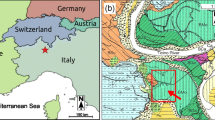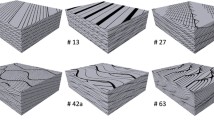Abstract
To assess differences between object and pixel-based reservoir modeling techniques, ten realizations of a UK Continental Shelf braided fluvial reservoir were produced using Boolean Simulation (BS) and Sequential Indicator Simulation (SIS). Various sensitivities associated with geological input data as well as with technique-specific modeling parameters were analyzed for both techniques. The resulting realizations from the object-based and pixel-based modeling efforts were assessed by visual inspection and by evaluation of the values and ranges of the single-phase effective permeability tensors, obtained through upscaling. The BS method performed well for the modeling of two types of fluvial channels, yielding well-confined channels, but failed to represent the complex interaction of these with sheetflood and other deposits present in the reservoir. SIS gave less confined channels and had great difficulty in representing the large-scale geometries of one type of channel while maintaining its appropriate proportions. Adding an SIS background to the Boolean channels, as opposed to a Boolean background, resulted in an improved distribution of sheetflood bodies. The permeability results indicated that the SIS method yielded models with much higher horizontal permeability values (20–100%) and lower horizontal anisotropy than the BS versions. By widening the channel distribution and increasing the range of azimuths, however, the BS-produced models gave results approaching the SIS behavior. For this reservoir, we chose to combine the two methods by using object-based channels and a pixel-based heterogeneous background, resulting in moderate permeability and anisotropy levels.
Similar content being viewed by others
REFERENCES
Alabert, F. G., and Massonnat, G. J., 1990, Heterogeneity in a complex turbiditic reservoir: Stochastic modeling of facies and petrophysical variability: paper SPE 20604 presented at the 1990SPE Annual Technical Conference & Exhibition, New Orleans, LA, Sept. 23–26, p. 775–790.
Alabert, F. G., and Modot, V., 1992, Stochastic models of reservoir heterogeneity: Impact on connectivity and average permeabilities: paper SPE 24893 presented at the 1992 SPEAnnual Technical Conference & Exhibition, Washington, DC, Oct. 4–7, p. 355–370.
Begg, S. H., Kay, A., Gustason, E. R., and Angert, P. F., 1994, Characterization of a complex fluvialdeltaic reservoir for simulation: paper SPE 28398 presented at the 1994 SPE Annual Technical Conference & Exhibition, New Orleans, LA, Sept. 25–28, p. 375–384.
Bratvold, R. B., Holden, L., Svanes, T., and Tyler, K., 1994, STORM: Integrated 3D stochastic reservoir modeling tool for geologists and reservoir engineers: paper SPE 27563 presented at the 1994 SPE European Petroleum Computer Conference, Aberdeen, UK, March 15–17, p. 243–261.
Damsleth, E., Tjølsen, C. B., Omre, H., and Haldorsen, H. H., 1992, A two-stage stochastic model applied to a North Sea Reservoir: Journal of Petroleum Technology, v. 44, no. 4, p. 402–408.
Deutsch, C. V., and Journel, A. G., 1992, GSLIB-Geostatistical software library and user's guide: Oxford University Press, Oxford, 340 p.
Haldorsen, H. H., and Damsleth, E., 1990, Stochastic modeling: Journal of Petroleum Technology, v. 42, no. 4, p. 404–412.
Hatløy, A. S., 1994, Numerical facies modeling combining deterministic and stochastic models, in Yarus, J. M., and Chambers, R. L., eds., AAPG Computer Applications in Geology No. 3, Stochastic modeling and geostatistics: Principles, methods and case studies: American Association of Petroleum Geologists, Tulsa, p. 109–120.
Holden, L., Hauge, R., Skare, Ø., Skorstad, A., 1998, Modeling of fluvial reservoirs with object models, Math. Geology, v. 30, no. 5, p. 473–496.
Journel, A. G., and Alabert, F. G., 1990, New method for reservoir mapping: Journal of Petroleum Technology, v. 42, no. 2, p. 212–218.
Journel, A. G., and Gómez-Hernández, J. J., 1993, Stochastic imaging of the Wilmington clastic sequence; SPE Formation Evaluation, v. 8, no. 1, p. 33–40.
Journel, A. G., Gundeso, R., Gringarten, E., and Yao, T., 1998, Stochastic modeling of a fluvial reservoir: A comparative review of algorithms, J. of Petroleum Science and Engineering, v. 21, no. 1–2, p. 95–121.
MacDonald, A. C., Høye, T. H., Lowry, P., Jacobsen, T., Aasen, J. O., and Grindheim, A. O., 1992, Stochastic flow unit modeling of a North Sea coastal-deltaic reservoir: First Break, v. 10, no. 4, p. 124–133.
Massonnat, G. J., Alabert, F. G., and Giudicelli, C. B., 1992, Anguille Marine, a deepsea-fan reservoir offshore Gabon: From geology to stochastic modeling: paper SPE 24709 presented at the 1992 SPE Annual Technical Conference & Exhibition, Washington, DC, Oct. 4–7, p. 477–492.
North, C. P., 1996, The prediction and modeling of subsurface fluvial stratigraphy, in Carling, P. A., and Dawson, M. R., eds., Advances in fluvial dynamics and stratigraphy: John Wiley & Sons, New York, p. 395–508.
Pickup, G. E., Ringrose, P. S., Forrester, M. M., Jensen, J. L., and Sorbie, K. S., 1994, The Geopseudo Atlas: Geologically based upscaling of multiphase flow: paper SPE 27565 presented at the European Petroleum Computer Conference, Aberdeen, UK, March 15–17, p. 277–289.
Seifert, D., Newbery, J. D. H., Ramsey, C., and Lewis, J. J. M., 1999, Evaluation of field development plans using 3-D reservoir modeling, in Schatzinger, R., and Jordan, J., eds.,AAPGMemoir No. 71, Recent Advances in Reservoir Characterization: American Association of Petroleum Geologists, Tulsa, p. 321–332.
Seifert, D., and Jensen, J. L., 1999, Sequential indicator simulation as a tool in reservoir description: Issues and uncertainties: Math. Geology, v. 31, no. 5, p. 527–550.
Srivastava, R. M., 1994, An overview of stochastic methods for reservoir characterization, in Yarus, J. M., and Chambers, R. L., eds., AAPG Computer Applications in Geology No. 3, Stochastic modeling and geostatistics: Principles, methods and case studies: American Association of Petroleum Geologists, Tulsa, OK, p. 3–16.
Tjølsen, C. B., Johnsen, G., Halvorsen, G., Ryseth, A., and Damsleth, E., 1996, Seismic data can improve stochastic facies modeling: SPE Formation Evaluation, v. 11, no. 3, p. 141–146.
Tyler, K., Henriquez, A., and Svanes, T., 1994, Modeling heterogeneities in fluvial domains: A review of the influence on production profiles, in Yarus, J. M., and Chambers, R. L., eds., AAPG Computer Applications in Geology No. 3, Stochastic modeling and geostatistics: Principles, methods and case studies: American Association of Petroleum Geologists, Tulsa, p. 77–89.
Author information
Authors and Affiliations
Rights and permissions
About this article
Cite this article
Seifert, D., Jensen, J.L. Object and Pixel-Based Reservoir Modeling of a Braided Fluvial Reservoir. Mathematical Geology 32, 581–603 (2000). https://doi.org/10.1023/A:1007562221431
Issue Date:
DOI: https://doi.org/10.1023/A:1007562221431




